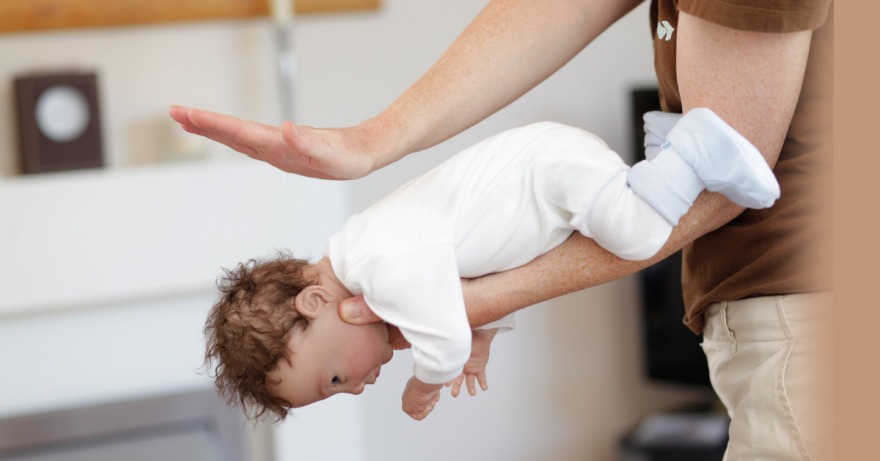Choking in babies is scary. As your baby reaches key milestones like starting solid foods or learning to crawl and walk, it’s an exciting time! However, it’s also crucial to be extra cautious as this period marks increased vulnerability to choke. Wondering, why babies are more vulnerable to choking? Discover more below for answers.
What is choking?
When babies choke, their airway can get partially or fully blocked, making it hard for them to breathe. When you start introducing solid foods or when they play with small objects during weaning, babies face a higher risk of choking.
Signs, Symptoms and The Cause
The danger symptomps and signs of choking are:
- Bluish skin color (cyanosis)
- Difficulty breathing — ribs and chest pull inward
- Loss of consciousness (unresponsiveness) if blockage is not cleared
- Inability to cry or make much sound
- Weak, ineffective coughing
- Soft or high-pitched sounds while inhaling.
The Cause
Choking in infants is usually caused by breathing in a small object that the baby has placed in their mouth, such as a button, coin, balloon, toy part, or watch battery. Choking may result from a complete or partial blockage of the airway. For a complete blockage you will need medical emergency. A partial blockage can quickly become life threatening if the baby cannot get enough air. When a person does not get enough air, permanent brain damage can occur in as little as 4 minutes.
Prevention tips
You may not be able to prevent all choking accidents. However, you can take measures to make your home as safe as possible for your baby. Here are some tips:
- Pay attention at mealtime: Especially as you introduce solid foods, it’s crucial to closely take a look to your child while they eat. Ensure your child sits during meals rather than walking or running around.
- Offer foods suitable for your child’s age: It refers to beginning with purees and gradually introducing larger, soft foods that your baby can easily mash in their mouth. For instance, consider starting with boiled sweet potatoes instead of raw carrots or small pieces of avocado rather than chunks of orange.
- Control with your doctor: Prior to introducing high-risk foods such as grapes and peanut butter, consult your pediatrician. They can guide you on the ideal timing for introducing these foods and suggest safe ways to present them to reduce the risk of choking.
- Review toy labels: to ensure they’re suitable for your baby’s age. Also, inspect other toys in your home that may belong to older siblings. Consider setting aside a specific area for toys with small parts to keep them away from the floor.
- Create a safe space: Keep other hazards, like batteries or coins, out of your baby’s reach. If babyproofing your entire home seems overwhelming, you might try creating a dedicated “safe space” that’s gated off while you work on babyproofing the rest.
You may not be able to prevent all choking accidents. However, you can take measures to make your home as safe as possible for your baby. Here are some tips:
- Pay attention at mealtime: Especially as you introduce solid foods, it’s crucial to closely take a look to your child while they eat. Ensure your child sits during meals rather than walking or running around.
- Offer foods suitable for your child’s age: It refers to beginning with purees and gradually introducing larger, soft foods that your baby can easily mash in their mouth. For instance, consider starting with boiled sweet potatoes instead of raw carrots or small pieces of avocado rather than chunks of orange.
- Control with your doctor: Prior to introducing high-risk foods such as grapes and peanut butter, consult your pediatrician. They can guide you on the ideal timing for introducing these foods and suggest safe ways to present them to reduce the risk of choking.
- Review toy labels: to ensure they’re suitable for your baby’s age. Also, inspect other toys in your home that may belong to older siblings. Consider setting aside a specific area for toys with small parts to keep them away from the floor.
- Create a safe space: Keep other hazards, like batteries or coins, out of your baby’s reach. If babyproofing your entire home seems overwhelming, you might try creating a dedicated “safe space” that’s gated off while you work on babyproofing the rest.
What babies can choke on
You may not be able to prevent all choking accidents. However, you can take measures to make your home as safe as possible for your baby. Here are some tips:
- Grapes (If giving these to your older baby — they’re not appropriate until closer to a year of age — peel off the skin and cut in half first.)
- Chunks of raw fruits or vegetables
- Chunks of meat or cheese
- Popcorn
- Nuts or seeds
- Peanut butter (While perhaps technically a puree, the thickness and stickiness makes it a hazard.)
- Marshmallows
- Hard candies
Other choking hazards found around the home include:
- Toys with small parts
- Latex balloons (uninflated)
- Coins
- Button batteries
- Pen caps
- Dice
- Other small household items
Young babies may also choke on liquids, like breast milk, formula, or even their own spit-up or mucus. Their airways are particularly small and easily obstructed. This is one reason that you hold your baby with his head below his chest when attempting to help. Gravity may allow the liquid to drain out and clear the airway.
Step-by-step First Aid when your baby is choking
The most common food that may cause of choking with infants. That’s why it’s important to introduce only age-appropriate foods — usually purees — to your child after they turn 4 months old.
- Step 1: Verify that your baby is actually choking, Your baby may be coughing or gagging. This can sound and look scary, but if they’re making noise and able to take breaths, they’re likely not choking. Choking is when a baby is unable to cry or cough. They also won’t be able to make any noise or breathe because their airway is completely obstructed.
- Step 2: Call 911, Ideally, you can have a friend or family member call 911 or local emergency services while you take care of your baby. Explain the steps you’re following to the operator and provide updates. It’s especially important that you tell the operator if your child becomes unconscious at any point during the process.
- Step 3: Place your baby face down on your forearm, Use your thigh for support. With the heel of your free hand, deliver five blows to the area between their shoulder blades. These blows should be both quick and strong to be effective. This action creates vibrations and pressure in your baby’s airway that will hopefully force the object out.
- Step 4: Turn baby over onto their back, Rest your baby on your thigh, keeping their head lower than their chest. With your index and middle fingers, find your baby’s breastbone (between and slightly below the nipples). Press down five times with enough pressure to press the chest down about one-third.
- Step 5: Performing CPR, If your baby does lose consciousness, try to do the CPR. The goal of CPR isn’t necessarily to bring your baby back to consciousness. Instead, it’s to keep the blood and oxygen circulating to their body and — even more importantly — to their brain.
- One set of CPR includes 30 chest compressions and 2 rescue breaths
- Place your infant on a flat, firm surface, like the ground.
- Place two fingers on your baby’s breastbone (the area where you applied pressure for chest thrusts). Compresses their chest about one-third (1 1/2 inches) at a rhythm of around 100 to 120 compressions each minute. Complete 30 chest compressions in all.
- Tilt your baby’s head back and lift their chin to open the airway and give two rescue breaths.
- Repeat the steps.


Leave a Reply